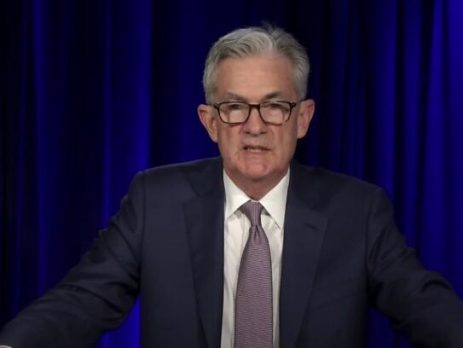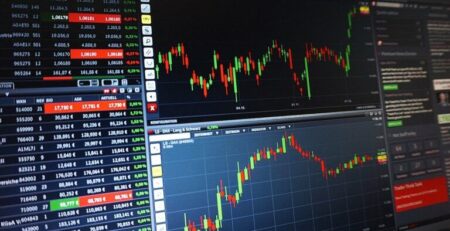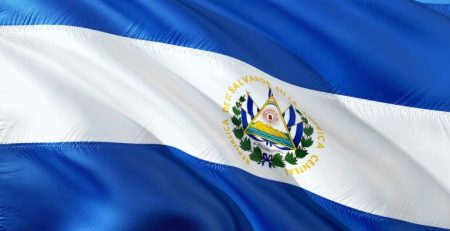$ADA Standing Strong As Most Cryptoassets Drop In the Wake of Upcoming Fed Meeting
On Wednesday (September 21), as global markets nervously wait for the conclusion of this month’s meeting of the Federal Open Market Committee (FOMC), most non-stablecoin top 20 cryptoassets are in the red, but $ADA is not one of those.
Currently (i.e. as of 10:10 a.m. UTC on September 21), according to data by CryptoCompare, most top 20 assets (by market cap) are experiencing losses; for example, Bitcoin ($BTC), Ethereum ($ETH), and Polygon ($MATIC) are trading around $19,005 (-1.41%), $1,338 (-1.12%), and $0.727 (-2.61%) respectively.
Meanwhile, Cardano ($ADA) is trading around $0.45, up 1.24% in the past 24-hour period.
And the reason is clear. Later today, Federal Reserve Chair Jerome Powell will announce how much the FOMC has decided to raise the federal funds rate, which the Federal Reserve Bank of St. Louis defines as “the interest rate at which depository institutions trade federal funds (balances held at Federal Reserve Banks) with each other overnight. “
Here is some more information from St. Louis Fed about the federal funds rate:
“The Federal Open Market Committee (FOMC) meets eight times a year to determine the federal funds target rate. As previously stated, this rate influences the effective federal funds rate through open market operations or by buying and selling of government bonds (government debt). More specifically, the Federal Reserve decreases liquidity by selling government bonds, thereby raising the federal funds rate because banks have less liquidity to trade with other banks. Similarly, the Federal Reserve can increase liquidity by buying government bonds, decreasing the federal funds rate because banks have excess liquidity for trade.
“Whether the Federal Reserve wants to buy or sell bonds depends on the state of the economy. If the FOMC believes the economy is growing too fast and inflation pressures are inconsistent with the dual mandate of the Federal Reserve, the Committee may set a higher federal funds rate target to temper economic activity. In the opposing scenario, the FOMC may set a lower federal funds rate target to spur greater economic activity.
“Therefore, the FOMC must observe the current state of the economy to determine the best course of monetary policy that will maximize economic growth while adhering to the dual mandate set forth by Congress. In making its monetary policy decisions, the FOMC considers a wealth of economic data, such as: trends in prices and wages, employment, consumer spending and income, business investments, and foreign exchange markets.
“The federal funds rate is the central interest rate in the U.S. financial market. It influences other interest rates such as the prime rate, which is the rate banks charge their customers with higher credit ratings. Additionally, the federal funds rate indirectly influences longer- term interest rates such as mortgages, loans, and savings, all of which are very important to consumer wealth and confidence.“
Although most analysts are expecting a 75 basis points (i.e. 0.75%) rate hike, there are some who believe that there is a 20% chance of a 100 basis points rate increase because inflation in the U.S. went up more than expected in August.
As you may remember, on September 13, the U.S. Bureau of Labor Statistics reported that “the Consumer Price Index for All Urban Consumers (CPI-U) rose 0.1 percent in August on a seasonally adjusted basis after being unchanged in July,” and that “over the last 12 months, the all items index increased 8.3 percent before seasonal adjustment.”
Of course, as every $ADA HODLer knows, everyone in the Cardano community is super excited about tomorrow’s Vasil upgrade on the Cardano mainnet,
On 10 December 2021, IOG Co-Founder and CEO Charles Hoskinson explained that he was going to honour his Bulgarian friend and Cardano ambassador Vasil Stoyanov Davov — who sadly passed away in his apartment in Plovdiv, Bulgaria on 3 December 2021 after a lengthy battle with pulmonary embolism” — by naming the next hard fork after him. Vasil was an artist, entrepreneur, blockchain consultant, Haskell practioneer, and ginkgologist. Furthermore, it would not be an exaggeration to say that he was a highly beloved and respected member of the Cardano community.
On September 16, Tim Harison, VP of Community & Ecosystem at Input Output Global (“IOG”), the blockchain technology company behind Cardano’s R&D, published a blog post in which he talked about what we should expect from Cardano’s Vasil upgrade.
Harrison started by saying that the Vasil upgrade, which will be deployed to the Cardano mainnet on September 22, will “significantly improves and enhances Cardano’s capabilities,” with “new Plutus v2 features and enhancements” allowing “DApp developers to create novel and exciting experiences” and diffusion pipelining enabling “greater throughput and network capacity.”
He then noted that “the new capabilities (including node and CLI support for reference inputs, inline datums, reference scripts, and collateral outputs), along with a new Plutus cost model” would become available on the mainnet one epoch (i.e. five days) after the Vasil HFC event; in other words, on September 27.
According to Harrison, these are the main enhancements to Plutus:
- Reference inputs (CIP-31). “This upgrade enables data sharing on-chain.”
- Inline datums (CIP-32). “Transaction datums were previously attached to outputs as hashes… This simplifies how datums are used – a user can see the actual datum rather than supply it to match the given hash.“
- Reference scripts (CIP-33). “This significantly reduces transaction size, improves throughput, and reduces script execution costs (since the script only needs to be paid for once).
- Datums and redeemers. This allows developers to “see redeemers for all inputs rather than just the one being passed to the currently executing script.“
- Data Serialisation primitive. This “reduces the overall memory and CPU costs allowing for more optimized and generic ways of data serialization.“
As for diffusion pipelining, Harrison says that this will “improve scalability by enabling further performance improvements,” and that we can expect “a ‘spike’ in activity immediately following the upgrade – as the community test drives the capabilities.”
Finally, as for what lies ahead for Cardano in the next week or so, he presented the following deployment timeline:
It is worth mentioning that “Vasil arrives in the month of Cardano’s fifth anniversary” and that September 22, which is when the Vasil HFC gets triggered on the Cardano mainnet happens to be “the anniversary of the 1908 declaration of independence of the Bulgarian state (one of the oldest in Europe) from the Ottoman empire.”












Leave a Reply